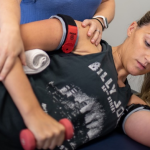Imaging May Not Tell The Whole Pain Story
Author: Dr. Aaron Bass, PT, CSCS
You’ve had some knee pain for a while, and you decide to finally go to the doctor to get it checked out. You’ve been dealing with it for months, maybe years, and decide that enough is enough. They decide to give you an X-ray and come back with that dreaded word… arthritis. What does that mean? Is your knee going to hurt forever unless you get a replacement? Do you need to stop doing all your favorite activities that involve being on your feet? What if your knee replacement sets off metal detectors so TSA arrests you and you’re never allowed to go on vacation again?! Alright, maybe that last question is a little extreme, but the point still stands, the diagnosis can make your head spin and fill with questions and fear.
Arthritis, plain and simple, is inflammation in the joint. This inflammation is typically associated with degeneration or weakening of cartilage or other connective tissue in or surrounding the joint and can cause pain.1 About 50% of people in the US over the age of 65 have been diagnosed with arthritis.2 That sounds bad right? Right now you’re thinking “what is the point of this article? All it is doing is scaring me more? I’m going to go back to watching The Great British Bake Off and try not to think about it anymore.” Well, here is the good news, it doesn’t have to be nearly as scary as it sounds. Imaging does not tell the whole story. Arthritis, on its own, does not necessarily cause pain. A 2020 study performed knee MRIs on 115 people with no pain. The results? Abnormalities were found in 97%of knees. 57% showed cartilage abnormalities with 31% being moderate to severe damage.3 Similar studies have been completed at the other regions of the body.4 Even diagnoses as scary sounding as disc bulges in the low back and neck have been found in a significant percentage of people with no complaints of pain.5,6 So what’s the deal? How do all these people have a laundry list of abnormalities and injuries, yet have no pain whatsoever. They must be lying. Bunch of liars. That’s the only explanation. Or maybe witchcraft.
OR maybe pain is more complex than that. Maybe you are more than what your X-ray or MRI says you are. Maybe arthritis and joint degeneration are more likely to be correlated with aging as opposed to being correlated with actual pain.7,8 Actual structural damage to joints or soft tissue are often only a part of the explanation for why we experience pain. In fact, it’s fairly common to experience pain in the absence of significant X-ray or MRI findings.8 Other potential causes of pain are going to include fear, anxiety, stress, socioeconomic factors, sleep quality, diet, activity levels, general outlook and expectations, etc.9 Simply being aware of these other factors playing a role in your pain could be your first step to feeling better.10
“So, what do I do with this information? Just chill out, get over it, and stop hurting?” Start by trying to modify your activities. Go for a walk, drink more water, eat better, get more sleep, try to relax, and don’t catastrophize the pain you’re feeling. If you’re comfortable easing your way into it, try some light resistance training.11 Research has shown exercise can not only have an effect in treating or preventing arthritis, but can also be used to help prevent at least 26 different psychiatric, neurological, metabolic, cardiovascular, pulmonary, and musculoskeletal diseases.12 Doesn’t have to be complicated, just start moving.
Now I am not saying X-rays are bad and knee replacements aren’t necessary. What I am saying is, you can save yourself a lot of time, money, and worry if you take some other steps first. Do what the research recommends: move, reduce causes of inflammation (eat, sleep, drink better), and see a qualified physical therapist that will give you a specific treatment plan to manage your pain and improve your function.
- “What Is Arthritis?: Arthritis Foundation.” What Is Arthritis? | Arthritis Foundation, www.arthritis.org/health-wellness/about-arthritis/understanding-arthritis/what-is-arthritis. Accessed 23 Aug. 2023.
- “Arthritis Related Statistics.” Centers for Disease Control and Prevention, Centers for Disease Control and Prevention, 22 June 2023, www.cdc.gov/arthritis/data_statistics/arthritis-related-stats.htm.
- Horga LM, Hirschmann AC, Henckel J, Fotiadou A, Di Laura A, Torlasco C, D’Silva A, Sharma S, Moon JC, Hart AJ. Prevalence of abnormal findings in 230 knees of asymptomatic adults using 3.0 T MRI. Skeletal Radiol. 2020 Jul;49(7):1099-1107. doi: 10.1007/s00256-020-03394-z. Epub 2020 Feb 14. PMID: 32060622; PMCID: PMC7237395.
- Blankenstein T, Grainger A, Dube B, Evans R, Robinson P. MRI hip findings in asymptomatic professional rugby players, ballet dancers, and age-matched controls. Clin Radiol. 2020 Feb;75(2):116-122. doi: 10.1016/j.crad.2019.08.024. Epub 2019 Sep 30. PMID: 31582172.
- Brinjikji W, Luetmer PH, Comstock B, Bresnahan BW, Chen LE, Deyo RA, Halabi S, Turner JA, Avins AL, James K, Wald JT, Kallmes DF, Jarvik JG. Systematic literature review of imaging features of spinal degeneration in asymptomatic populations. AJNR Am J Neuroradiol. 2015 Apr;36(4):811-6. doi: 10.3174/ajnr.A4173. Epub 2014 Nov 27. PMID: 25430861; PMCID: PMC4464797.
- Nakashima H, Yukawa Y, Suda K, Yamagata M, Ueta T, Kato F. Abnormal findings on magnetic resonance images of the cervical spines in 1211 asymptomatic subjects. Spine (Phila Pa 1976). 2015 Mar 15;40(6):392-8. doi: 10.1097/BRS.0000000000000775. PMID: 25584950.
- Polat CS, Doğan A, Sezgin Özcan D, Köseoğlu BF, Koçer Akselim S. Is There a Possible Neuropathic Pain Component in Knee Osteoarthritis? Arch Rheumatol. 2017 Apr 24;32(4):333-338. doi: 10.5606/ArchRheumatol.2017.6006. PMID: 29901006; PMCID: PMC5868471.
- Hannan MT, Felson DT, Pincus T. Analysis of the discordance between radiographic changes and knee pain in osteoarthritis of the knee. J Rheumatol. 2000;27:1513–1517.
- The Psychology of Pain and Pain Perception – Practical Pain Management, www.practicalpainmanagement.com/treatments/psychological/perseverance-loop-psychology-pain-factors-pain-perception. Accessed 23 Aug. 2023.
- Adriaan Louw, Kory Zimney, Emilio J. Puentedura & Ina Diener (2016) The efficacy of pain neuroscience education on musculoskeletal pain: A systematic review of the literature, Physiotherapy Theory and Practice, 32:5, 332-355, DOI: 10.1080/09593985.2016.1194646
- Li Y, Su Y, Chen S, et al. The effects of resistance exercise in patients with knee osteoarthritis: a systematic review and meta-analysis. Clinical Rehabilitation. 2016;30(10):947-959.
- Pedersen, B.K. and Saltin, B. (2015), Exercise as medicine – evidence for prescribing exercise as therapy in 26 different chronic diseases. Scand J Med Sci Sports, 25: 1-72. https://doi.org/10.1111/sms.12581






